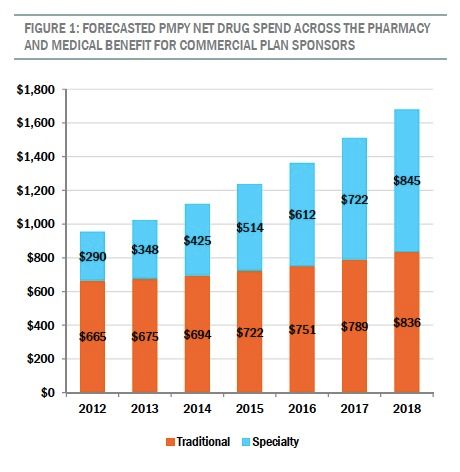Specialty Drugs and Reimbursement
By 2018, the amount health insurers spend per person on specialty, or biologic drugs, will equal or surpass the amount spent on traditional products, according to a new report.
To maximize return on investment, pharma must think strategically about reimbursement channels and how new specialty products will perform in one versus another.

PMPY = Per Member, Per Year. Source: Artemetrx
By 2018, the amount health insurers spend per person on specialty, or biologic drugs, will equal or surpass the amount spent on traditional products, according to a new report. With the emergence of newer, self-administered injectables and oral dosages, many specialty products are and will be reimbursed through a pharmacy benefit, in contrast to a medical benefit, which covers products administered in a hospital or clinic.
The Artemetrx report, titled Specialty Drug Trend Across the Pharmacy and Medical Benefit, found that commercial health plans would do well to integrate management strategies across the pharmacy and medical benefit, the latter being “richest in savings opportunities,” from a payer perspective. Indeed, the “identification of lower cost sites of care under the medical benefit is often the most significant area of opportunity [for savings] in terms of total dollars,” according to the report.
Since a premium is commanded for drugs (and services) provided in a hospital or clinic, should pharma target the medical benefit as the reimbursement channel of choice for specialty drugs? Not necessarily, says Mason Tenaglia, managing director at the Amundsen Group. Drug companies “have a lot more control” over reimbursement when it happens “through the pharmacy channel, because [drug makers] have the opportunity to go directly to the patient and physician, as opposed to being controlled by an institutional setting and a purchasing department.”
Medicare, for example, might pay more for a cancer treatment administered at a hospital, than it would for an oral drug that offers the same health outcome, says Tenaglia. In this scenario, the cost of an oral drug, processed through a pharmacy benefit, would be shouldered to a larger extent by the patient.
With ongoing discussions around the cost of healthcare, at the state and federal level, it’s likely that public and private plans alike will continue to squeeze cost savings from the system whenever possible. Given the costs associated with specialty drugs, and the increasing number of biologic drug approvals, pharma will need to anticipate the squeeze, and figure out, on a case by case (and drug by drug) basis, which reimbursement channel provides the most favorably contoured corset.
Beyond the Prescription: Pharma's Role in Digital Health Conversations
April 1st 2025Join us for an insightful conversation with Jennifer Harakal, Head of Regulatory Affairs at Canopy Life Sciences, as we unpack the evolving intersection of social media and healthcare decisions. Discover how pharmaceutical companies can navigate regulatory challenges while meaningfully engaging with consumers in digital spaces. Jennifer shares expert strategies for responsible marketing, working with influencers, and creating educational content that bridges the gap between patients and healthcare providers. A must-listen for pharma marketers looking to build trust and compliance in today's social media landscape.
Talphera Cuts NEPHRO CRRT Study Size, Secures $14.8 Million Private Placement
April 1st 2025The trial size adjustment, along with protocol modifications and the addition of higher-enrollment sites, is expected to facilitate completion of the NEPHRO CRRT study of Niyad in patients undergoing renal replacement therapy by the end of 2025.